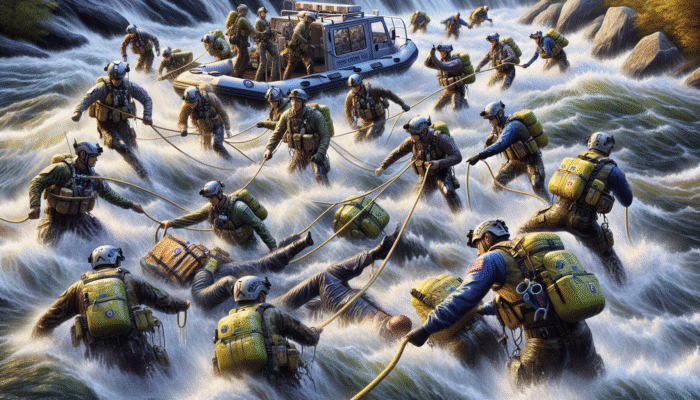Strategic Planning and Preparation for Successful Flood Rescue Operations
Conducting Detailed Risk Assessments in Flood Vulnerable Areas

Identifying flood-prone areas is an essential and strategic step towards developing effective flood rescue techniques. Rescue teams can leverage geographic data, historical flooding patterns, and environmental vulnerabilities through meticulous risk assessments. This critical process encompasses the mapping of regions that have historically been susceptible to flooding, evaluating infrastructure weaknesses, and understanding the socio-economic repercussions on local communities. For instance, locations like Louisiana in the United States and the Sundarbans in India and Bangladesh are frequently inundated, making it imperative to gain insights into their specific challenges to formulate effective planning and response strategies.
Furthermore, the risk assessment process must involve invaluable community feedback. Engaging with local residents can uncover hidden risks that numerical data might overlook. By conducting surveys and organising public forums, rescue planners can gather meaningful insights about past flooding experiences, which can inform future strategies. Implementing advanced technology such as Geographic Information Systems (GIS) enhances the depth of analysis, allowing for real-time updates on emerging flood risks, thereby facilitating a more proactive approach to flood management.
Ultimately, a comprehensive and systematically organised risk assessment forms the backbone of the entire rescue strategy, supporting effective resource allocation. This preparation guarantees that emergency kits and personnel are strategically positioned in high-risk areas well ahead of any impending disaster, significantly increasing the likelihood of successful rescue operations and saving lives.
Assembling Well-Equipped Emergency Kits for Flood Preparedness
Putting together robust emergency kits is a cornerstone of preparedness in flood rescue techniques. These essential kits should include supplies such as life jackets, ropes, first-aid kits, flashlights, non-perishable food, water, and other vital survival items that can prove indispensable during a flood event. The specific contents may vary depending on local needs, prevailing weather conditions, and the demographic characteristics of the communities being served, ensuring that each kit is personalised to meet the unique requirements of the community it is intended for.
For example, in coastal regions where flooding is frequently accompanied by storm surges, it becomes crucial to incorporate waterproof gear and communication devices. Similarly, safety tools such as hiking gear and portable water filtration systems should be included in mountainous regions susceptible to flash floods. Each kit must be meticulously tailored to address the specific needs of its community, ensuring that cultural and practical considerations are adequately represented to promote effective responses during crises.
Regular inspections and updates of these emergency kits are essential for maintaining their effectiveness. Items can expire or become damaged over time, and the contents of the kits should reflect the current risks relevant to the community. Training local teams on the effective deployment of these tools during a crisis can also significantly bolster preparedness and enhance the overall effectiveness of any rescue operation.
Implementing Comprehensive Training Programs for Rescue Personnel
Conducting regular and comprehensive training sessions is vital to ensuring that rescue teams possess the necessary skills and knowledge to perform effectively under pressure. Training in flood rescue techniques should cover a diverse range of scenarios, including swift water rescue, medical response, and crucial interpersonal communication skills essential for fostering team dynamics and engaging with victims effectively.
One innovative strategy is to incorporate simulation exercises that closely mimic real flood conditions. These hands-on experiences allow teams to practice their coordination and decision-making during emergencies, which can prove invaluable when faced with actual disaster situations. Furthermore, cross-training with other emergency services—such as firefighters and medical responders—can foster collaboration and mutual understanding of each agency's capabilities and limitations, ultimately enhancing the overall effectiveness of rescue operations.
Global examples of successful training programmes can be observed in regions prone to flooding. For instance, Brazil has implemented community engagement initiatives that train local volunteers in basic rescue operations, thereby enhancing overall community resilience. These innovative training programmes can be adapted globally, providing excellent models for best practices in flood response training, which can lead to improved outcomes in times of crisis.
Executing Rescue Operations with Accuracy and Effectiveness

Utilising Boats for Effective Flood Rescues
The use of boats in flood rescue techniques is indispensable for navigating inundated areas with limited ground access. Boats can vary from small inflatable rafts to larger rescue vessels, each designed to suit specific conditions encountered during rescue operations. The choice of a boat is influenced by a range of factors, including water depth, current speed, and the presence of debris, which can create hazardous conditions for rescuers.
Rescue teams must undergo extensive training in boat handling and navigation techniques. A thorough understanding of water dynamics, such as currents and tides, can significantly impact the safety and success of a rescue operation. For example, during the catastrophic flooding in Houston, Texas, in 2017, boat rescues were crucial in reaching stranded residents in hard-to-access neighbourhoods, underscoring the necessity of proper training in these critical situations.
Moreover, integrating technology such as GPS and sonar can greatly enhance search and rescue operations. Drones, for instance, are increasingly utilised to survey areas from above, significantly aiding in the identification of stranded individuals before deploying rescue boats. This incorporation of technology streamlines operations and ensures that teams can respond swiftly and effectively, maximising the chances of saving lives during emergencies.
Executing Helicopter Evacuations for Rapid Response
In scenarios where ground access is impractical, helicopter evacuations become essential in flood rescue techniques. Helicopters possess the capability to quickly reach isolated areas, airlifting individuals to safety within minutes. This rapid response capability is especially critical during large-scale disasters where every second counts and timely action is paramount.
Extensive pilot training is crucial for these operations, as flying in adverse weather conditions presents unique challenges. Helicopter crews must be adept at assessing landing zones, even in difficult environments, to ensure the safety of both rescuers and the individuals they are attempting to evacuate. During the floods in Thailand in 2011, helicopter evacuations played a pivotal role in reaching remote communities cut off by rising waters. These life-saving operations underscore the importance of well-coordinated aerial rescue strategies that can adapt to rapidly changing situations.
Furthermore, arranging for medical personnel to accompany helicopter crews is vital to ensure that evacuated individuals receive immediate care for any injuries or health concerns sustained during the flooding. Incorporating trained medical teams into helicopter operations enhances the overall effectiveness of rescues, addressing both immediate survival needs and long-term health issues that may arise after such traumatic events.
Mastering Swiftwater Rescue Techniques for Enhanced Safety

Executing rescues in fast-moving water necessitates specialised skills and techniques for flood rescue operations. Swiftwater rescue training emphasises a comprehensive understanding of water dynamics, including currents and eddies, to navigate these hazardous environments safely, ensuring the safety of both rescuers and victims alike.
Rescue personnel must undergo rigorous training in self-rescue techniques and how to securely approach and assist victims in turbulent waters. Essential equipment includes personal flotation devices, throw bags, and specialised harnesses designed to facilitate secure rescues. Ropes for stability and secure attachments can significantly impact the ability to reach individuals in distress, ensuring the safety of both the rescuer and the victim during these critical moments.
Global examples can be found in regions like Australia, where swiftwater rescue teams routinely participate in drills and simulations to refine their skills. These teams often collaborate with local authorities to ensure that community preparedness is at its peak, significantly enhancing the overall response to flooding incidents. Emphasising continuous training and collaboration fosters confidence and effectiveness during rescue operations, ultimately saving lives when it matters most.
Implementing Urban Search and Rescue Strategies
Conducting operations in urban environments necessitates a unique set of strategies within flood rescue techniques. Urban flooding can lead to structural collapses and debris, posing additional risks for victims and rescuers alike. Consequently, teams must be extensively trained to navigate these complex environments while prioritising safety and operational efficiency above all else.
Integrating advanced technologies such as thermal imaging and search cameras can significantly enhance search efforts in urban settings. These tools allow rescuers to swiftly locate individuals trapped under debris or in flooded structures, expediting the rescue process considerably. Collaborative efforts with urban planners can also enhance resilience, ensuring that critical infrastructure is designed with flood risks firmly in mind, thus reducing the potential impact of future events.
The devastating impact of the 2005 Hurricane Katrina disaster in New Orleans exemplifies the necessity of urban search and rescue operations. In the aftermath of the storm, rescue teams encountered immense challenges due to flooded streets and damaged buildings. The insights gained from such incidents have since shaped the protocols and techniques employed in urban rescue efforts globally, illustrating the need for ongoing improvement and adaptation in response strategies.
Establishing Effective Communication Strategies for Rescue Operations
Creating Reliable Radio Communication Systems for Enhanced Coordination
Establishing dependable radio communication is a fundamental element of successful flood rescue techniques. Effective communication ensures that rescue teams can synchronise their efforts in real-time, share critical information, and maintain contact throughout operations. Utilising secure and robust radio systems minimises the risk of communication failures that could jeopardise lives during crucial moments.
Training personnel in radio operation is essential for optimal functionality. Rescuers should be thoroughly familiar with the equipment, including troubleshooting common issues that may arise during an emergency. Regular drills can help reinforce communication protocols, ensuring every team member understands their role and responsibilities, thus facilitating a smoother response during crises.
Integrating multiple communication channels, such as satellite phones and handheld devices, can significantly enhance resilience. In areas where traditional communication networks may be compromised, having backup systems ensures that teams remain connected and can continue their operations. This redundancy is vital in regions prone to flooding, where the communication infrastructure may be vulnerable to failure during a crisis.
Utilising Signal Devices for Efficient Communication During Rescue Operations
Implementing visual and auditory signals plays a significant role in flood rescue techniques. Rescue teams must have access to a variety of signalling devices, including flares, whistles, and lights, to communicate effectively during operations. These devices can draw attention to rescue efforts, guide stranded individuals towards safety, and facilitate a more organised rescue process, ultimately enhancing efficiency.
Training on the use of these signals is crucial for operational success. Rescue teams should routinely practice identifying and responding to various signals while in the field to ensure familiarity and prompt action during emergencies. This preparedness not only facilitates efficient rescues but also fosters a more organised approach to operations, reducing confusion and panic among rescuers and victims alike.
In scenarios where visibility is compromised, such as during heavy rain or nighttime operations, ensuring that these devices are readily accessible and functional can make a significant difference. Developing a comprehensive signalling strategy tailored to local conditions ensures that teams can communicate effectively, even in challenging environments, maximising the effectiveness of rescue operations and ultimately saving lives.
Implementing Public Alerts for Timely Information Dissemination
Disseminating timely information to the public is imperative during flood emergencies. Effective public alert systems ensure that communities are informed about impending floods, evacuation orders, and critical safety measures. Utilising diverse communication channels—such as social media, text alerts, and local news—can significantly enhance outreach efforts, ensuring that information reaches as many individuals as possible during crucial moments.
Rescue agencies should collaborate closely with local governments and media outlets to create an efficient public alert system. Training community members to recognise and respond to alerts can greatly enhance preparedness, ensuring individuals know how to react swiftly and effectively during a flood crisis.
Educational campaigns also play a crucial role in fostering awareness in flood-prone areas. Regularly sharing information about flood risks, safety measures, and evacuation routes equips communities with the knowledge needed to act decisively when faced with an emergency. This proactive approach cultivates resilience, empowering individuals to take control in the face of disaster and ensuring their safety and that of their neighbours.
Implementing Critical Safety Measures for Rescuers During Flood Operations
Ensuring Proper Use of Personal Protective Equipment (PPE)
Ensuring that rescuers wear appropriate personal protective equipment (PPE) is of utmost importance in flood rescue techniques. Proper gear, including helmets, life vests, gloves, and waterproof clothing, minimises the risks associated with hazardous flood conditions. Each piece of equipment is essential in safeguarding rescuers from potential dangers they may encounter during operations, ensuring their safety and effectiveness.
Training personnel on the proper use of PPE is crucial for ensuring safety. Rescuers should understand how to select appropriate gear based on the specific flood environment they are entering. For example, in swiftwater rescues, specialised flotation devices may be necessary, while in urban environments, heavy-duty protective gear against debris may be required to ensure their safety throughout the operation.
Regular inspections and maintenance of PPE are vital to operational success. As rescue operations must adapt to changing conditions, so too must the equipment used. Ensuring that all gear is in optimal condition before deployments enhances the safety and effectiveness of rescue operations, ultimately protecting the lives of rescuers and victims alike.
Adhering to Established Safety Protocols During Rescue Missions
Following established safety protocols during rescue missions is essential for maintaining the safety of both rescuers and victims. These protocols should encompass all aspects of rescue operations, including risk assessment, equipment checks, and heightened situational awareness to mitigate potential dangers and ensure a safe response.
Effectively communicating safety protocols is imperative for operational success. Rescue teams should regularly review and practice these procedures to ensure every member understands their role and responsibilities. This familiarity fosters a culture of safety and preparedness, allowing teams to operate more effectively in high-stress situations where clarity is crucial.
Employing a systematic safety approach can significantly reduce risks during rescue operations. By implementing checklists and conducting briefing sessions before deployments, all safety measures are considered and addressed. Regular debriefing sessions post-rescue can also highlight challenges faced, allowing teams to refine their protocols and enhance future operations, thus continually improving their readiness for any situation.
Enhancing Hazard Awareness Among Rescuers
Training rescuers to recognise and avoid potential hazards in flood zones is critical to flood rescue techniques. Flooded areas can present various dangers, including unstable structures, submerged debris, and electrical hazards. Awareness of these risks is crucial for maintaining the safety of both rescuers and victims during operations, ensuring that teams can respond effectively and safely.
Conducting hazard assessments before and during rescue operations can help teams effectively identify and mitigate risks. Utilising visual aids and simulations during training sessions can enhance understanding and preparedness for real-life scenarios, ensuring that rescuers can tackle various challenges with confidence and skill.
Moreover, fostering a culture of awareness among community members can significantly enhance overall safety. Educating local populations on recognising hazards and practising personal safety measures can empower individuals to make informed decisions during flood emergencies, ultimately reducing the risk of injury or harm to themselves and others.
Implementing Robust Emergency Communication Systems
Ensuring reliable communication tools are available and functional is vital for effective coordination during rescue operations. Establishing a robust emergency communication system allows teams to share critical information, coordinate their efforts, and ensure the safety of all personnel involved in the rescue operations.
Regular testing and maintenance of communication systems are crucial for operational success. This includes checking radio equipment, satellite phones, and other devices used in the field. Ensuring that all personnel are trained in utilising these tools can minimise the risk of communication breakdowns during emergencies, facilitating a prompt response when needed most.
Additionally, integrating various communication methods can enhance resilience. Traditional methods, like radios, coupled with modern tools, such as mobile apps or social media platforms, ensure that teams can stay connected, even in challenging conditions. This multi-faceted approach can significantly improve the effectiveness of flood rescue techniques, ultimately saving more lives and ensuring a coordinated response.
Providing Comprehensive Victim Care During Flood Rescues
Delivering Immediate Medical Assistance to Flood Victims
Providing immediate medical care to rescued individuals is critical to flood rescue techniques. Flood victims may suffer from a range of injuries, including hypothermia, lacerations, and waterborne illnesses. Ensuring rescue teams have trained medical personnel on-site can significantly improve health outcomes for those affected by flooding events, addressing both immediate and long-term health concerns.
First aid training is essential for all rescuers, empowering them to address injuries and medical emergencies effectively. Teaching basic medical interventions, such as wound care and stabilization techniques, equips teams to provide immediate assistance before victims reach a medical facility for further treatment. This timely intervention can be life-saving in critical situations.
Moreover, establishing partnerships with local healthcare providers ensures a seamless transition for victims needing further medical attention. Local hospitals should be adequately prepared for an influx of patients during flood emergencies, with protocols in place to handle increased demand efficiently, thereby improving the overall care provided to those in need during such crises.
Offering Emotional Support to Flood Victims
Providing psychological support to flood victims is as crucial as offering physical care during rescue operations. The trauma of flooding can lead to long-term emotional distress, making it essential for rescue teams to be trained in basic psychological first aid techniques. Recognising signs of emotional distress and providing a supportive presence can help victims cope with the aftermath of their experiences, facilitating their recovery.
Incorporating mental health professionals into rescue operations can significantly enhance the support available to victims. These professionals can address immediate psychological needs, helping individuals process their experiences and develop effective coping strategies tailored to their unique situations, thereby promoting healing and resilience in the aftermath of trauma.
Community outreach programs after rescues can also play a critical role in emotional recovery. Providing resources and ongoing support for those affected fosters resilience and helps individuals rebuild their lives after a flood disaster, ultimately aiding their long-term recovery and reintegration into the community.
Arranging Shelter and Supplies for Displaced Individuals
Arranging temporary shelters and essential supplies for displaced individuals is vital to post-rescue efforts in flood rescue techniques. After a flood, many individuals may find themselves homeless or without access to necessities, making it crucial to establish safe, secure shelters quickly and efficiently to accommodate those in need.
Coordinating with local organisations and government agencies can streamline the process of providing shelter and supplies to those in need. Establishing partnerships with non-profits, community groups, and businesses ensures that victims have access to food, clothing, and hygiene supplies during their recovery, effectively addressing their immediate needs and restoring a sense of normalcy.
Moreover, involving community members in the recovery process fosters a sense of ownership and empowerment. Volunteer initiatives can assist in distributing supplies and managing shelter operations, promoting social cohesion and support among those affected, ultimately contributing to a more resilient community that can withstand future challenges more effectively.
Implementing Post-Rescue Actions for Future Preparedness
Conducting Thorough Debriefing Sessions After Rescue Operations
Conducting thorough debriefing sessions after rescue operations is crucial for continuous improvement in flood rescue techniques. These reviews provide an invaluable opportunity for teams to reflect on their experiences, identify successes, and pinpoint areas for enhancement to improve future operations significantly.
Encouraging open and honest communication during debriefing fosters a culture of learning and growth within rescue teams. Rescuers should feel comfortable sharing challenges faced during operations and innovative solutions discovered along the way. This collaborative approach can enhance strategies and techniques for future rescues, ultimately improving overall efficiency and effectiveness in flood response.
Documenting lessons learned and best practices from debriefing sessions ensures that knowledge is preserved and shared with future teams. Establishing a repository of insights can significantly enhance overall preparedness and response effectiveness in subsequent flood events, creating a continuous feedback loop for improvement that benefits the entire rescue community.
Maintaining Equipment for Future Rescue Operations
Ensuring that all rescue gear is properly maintained and ready for future use is essential for effective flood rescue techniques. Equipment checks should be a regular part of operational protocols, allowing teams to identify and address issues before they escalate and impact rescue efforts. Regular maintenance is vital for ensuring the reliability and functionality of all equipment used.
Creating a comprehensive inventory of rescue gear facilitates accountability and ensures all equipment is accounted for and maintained. Regular training on equipment handling and maintenance further enhances preparedness, allowing rescuers to utilise tools effectively when needed, maximising the chances of success during operations and ensuring that teams are well-prepared for any situation that may arise.
Investing in quality gear is also critical for operational success. Choosing durable and reliable equipment that can withstand the challenges presented by flood environments enhances the overall effectiveness of rescue operations, ensuring that teams are well-equipped to handle any situation and respond swiftly and efficiently.
Engaging in Community Outreach for Future Flood Preparedness
Engaging with the community post-rescue to share lessons learned is vital for enhancing future preparedness and resilience. Community outreach programmes can provide valuable information on flood risks, safety measures, and available resources, empowering individuals to take proactive steps for their safety in the face of future floods.
Collaborating with local schools, civic organisations, and community leaders can significantly enhance outreach efforts. Educational workshops, drills, and informational sessions can foster a culture of resilience, ensuring that communities are better prepared for future flood events and emergencies, ultimately leading to a more informed and proactive population.
Moreover, sharing success stories from rescue operations can inspire and motivate community members to engage in preparedness activities. Highlighting the positive impact of preparedness efforts fosters a sense of pride within the community and encourages individuals to take responsibility for their safety and that of their neighbours, ultimately creating a more resilient society capable of facing future challenges effectively.
Exploring Technological Innovations in Flood Rescue Operations
Revolutionising Flood Rescue Operations with Drones
The deployment of drones in flood rescue techniques has transformed the way teams assess flood situations and locate individuals in need of rescue. Drones equipped with high-resolution cameras can cover expansive areas rapidly, providing real-time data that enhances situational awareness and operational efficiency.
Utilising drones enables rescue teams to identify hazards, assess the extent of flooding, and locate victims without placing personnel at risk. This technology has proven invaluable in scenarios where ground access is impossible or perilous, significantly improving the safety and effectiveness of rescue operations and allowing for more comprehensive assessments of affected areas.
Training rescue personnel in drone operation is essential for maximising the benefits of this technology. Conducting simulations and drills can enhance familiarity with drone capabilities and limitations, ensuring that teams can effectively integrate this tool into their operations, thus improving overall outcomes and response times during emergencies.
Enhancing Flood Forecasting with Advanced Prediction Models
Advanced flood prediction models are crucial for forecasting flood events and planning effective rescue operations. These models analyse meteorological data, historical flooding patterns, and land use to accurately predict potential flooding scenarios, enabling teams to prepare proactively and allocate resources efficiently.
Incorporating these predictive analytics into rescue planning allows teams to allocate resources efficiently and prepare for anticipated flood impacts. For instance, cities like New Orleans have invested in advanced modelling systems to enhance their flood response strategies, helping to save lives and minimise damage during flooding events by ensuring that resources are directed where they are most needed.
Collaboration with meteorologists and data scientists can significantly enhance the accuracy of flood predictions. Regularly updating and refining models based on real-time data ensures that forecasts remain relevant and useful for planning purposes, ultimately improving the effectiveness of flood rescue operations and enabling teams to respond more effectively to emerging threats.
Transforming Community Response with Mobile Applications
The development of mobile applications to provide real-time flood data and rescue coordination tools is revolutionising how communities respond to flooding. These apps can deliver critical information, such as flood warnings, evacuation routes, and available resources, directly to users' smartphones, ensuring that vital information is accessible when needed most.
Incorporating features that allow users to report flooding conditions or request assistance enhances community engagement and empowers individuals to take an active role in their safety during flood events and emergencies. This collaborative approach fosters a sense of community and shared responsibility in responding to crises.
Ensuring these apps are user-friendly and accessible to diverse populations is vital for maximising their effectiveness. Providing language options, visual aids, and offline functionalities can expand the reach and effectiveness of these tools, ensuring that they serve all community members effectively and inclusively, ultimately enhancing preparedness and response capabilities across the board.
Frequently Asked Questions About Flood Rescue Techniques
What are the essential flood rescue techniques?
Flood rescue techniques encompass various strategies and methods used to safely evacuate individuals trapped in flooded areas. These techniques include boat rescues, helicopter evacuations, and swift water rescue operations, each tailored to specific situations and challenges encountered during floods, ensuring effective responses in diverse scenarios.
How can communities proactively prepare for floods?
Communities can prepare for floods by conducting thorough risk assessments, assembling emergency kits, and establishing comprehensive training programmes for rescue teams. Engaging residents in preparedness activities enhances community resilience and ensures a unified emergency response, ultimately safeguarding lives and property.
Why is training crucial for flood rescue teams?
Training is vital for flood rescue teams, equipping them with essential skills, knowledge, and the ability to respond effectively under pressure. Regular training sessions enhance coordination and confidence during rescue operations, ultimately improving outcomes for victims and ensuring that rescuers are well-prepared for various scenarios.
What role do drones play in effective flood rescue?
Drones are utilised in flood rescue to assess situations, locate stranded individuals, and gather real-time data. Their ability to cover large areas quickly enhances the efficiency of rescue operations while keeping personnel safe from hazardous conditions, thereby significantly improving response times and outcomes.
How should medical assistance be provided during rescue efforts?
Medical assistance during rescues should address immediate health concerns, such as injuries and waterborne illnesses. Having trained medical personnel on-site can significantly improve health outcomes for flood victims, ensuring they receive timely care and appropriate interventions during critical moments.
What essential safety measures should rescuers implement?
Rescuers should wear appropriate personal protective equipment, follow established safety protocols, and be trained in hazard awareness. Ensuring the safety of rescue personnel is paramount during operations to protect both rescuers and victims alike, ultimately enhancing the effectiveness of rescue efforts.
How can technology improve overall flood response?
Technology enhances flood response through advanced prediction models, mobile applications for real-time updates, and drones for situational assessment and monitoring. These tools improve coordination, efficiency, and effectiveness during rescue operations, ultimately saving lives and ensuring a more effective response.
What are the emotional support needs of flood victims during recovery?
Flood victims often require emotional support to cope with trauma and stress experienced during and after flooding. Providing psychological first aid and resources for ongoing support is essential for recovery, aiding individuals in processing their experiences and fostering resilience in the aftermath of disaster.
What is the significance of community outreach post-rescue?
Community outreach after a rescue is important for sharing lessons learned, enhancing future preparedness, and fostering a sense of community resilience. Engaging residents in recovery efforts empowers them to take action and contribute to a more resilient society capable of facing future challenges effectively.
How can public alerts assist communities during floods?
Public alerts provide timely information about impending floods, evacuation orders, and safety measures. Effective public communication ensures that communities are informed and well-prepared to respond quickly during emergencies, ultimately saving lives and minimising the impact of flooding.
Explore our journey on X!
The post Flood Rescue Techniques: Essential Methods and Tools appeared first on Survival Bite.
The Article Flood Rescue Techniques: Key Tools and Methods for Safety Was Found On https://limitsofstrategy.com

